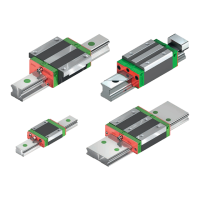Lubrication
41
Assembly instructions
Linear Guideways
GW-04-0-EN-1910-MA
8.4 Use of central lubrication system
We recommend that you carry out the initial lubrication (see Section 8.12) separately before connection to a central lubrica-
tion system, using a manual grease gun. It is also important to ensure that all pipes and elements up to the user are filled
with lubricant and contain no air pockets.
Long pipelines and narrow pipe diameters are to be avoided. The pipes are to be installed on an incline.
The pulse count results from the partial quantities and the piston distributor sizes.
In addition, the lubrication system manufacturer’s regulations must be observed.
8.5 Lubricating pressure
HIWIN rail guideways can be lubricated using oil, grease or low-viscosity grease, depending on the specific application.
The required lubricating pressure depends on the size, the lubricant, the length of the feed line and the type of lubrication
connection used.
Minimum lubricating pressure on the block:
| Grease or low-viscosity grease: 6 bar
| Oil lubrication: 3 bar
The maximum permissible lubricating pressure on the block is 30 bar.
8.6 Selecting a lubricant
Oils, greases or low-viscosity greases can be used as lubricants. The same lubricants are used as for antifriction bearings. As
a rule, the selection of a lubricant and the infeed method can be adapted to fit in with the lubrication of the other machine
components.
Essentially, the selection of a lubricant depends on the operating temperature and various operation-related factors, e.g.
load, vibrations, oscillation or short-stroke applications. Special requirements – such as use in combination with strong or
aggressive media, in clean rooms, in a vacuum or in the food industry – also need to be considered.
Damage to the block can be caused by excessive lubricating pressure levels or lubricant quantities.
Seals are at particular risk of damage on blocks with double seals, SW seals or ZWX seals.
X Carry out lubrication according to the assembly instructions.
X Make sure you use the right lubricating pressure levels and lubricant quantities.
ATTENTION!
Grease lubrication
For grease lubrication, we recommend lubricating greases for rolling bearings and friction bearings with mineral oil as the
base oil and thickeners specified by DIN 51825 (K1K, K2K). In heavy-duty applications, we recommend using EP additives
(KP1K, KP2K), NLGI class 1 or 2. Using greases of other consistency classes is possible subject to the approval of the
lubricant supplier.
Lubrication with low-viscosity grease
In centralised lubrication systems, low-viscosity greases are frequently used, as they are distributed more effectively over
the whole system due to their soft structure.
Oil lubrication
Lubricating oils offer the advantage of more even distribution and reach the contact surfaces more effectively. However, this
also means that lubricating oils collect in the lower area of the product as a result of the force of gravity and thus cause
soiling more quickly. For this reason, higher quantities of lubricant are required than with grease lubrication. As a rule, oil lu-
brication is only suitable when a centralised lubrication system is being used or for products equipped with a lubrication unit.

